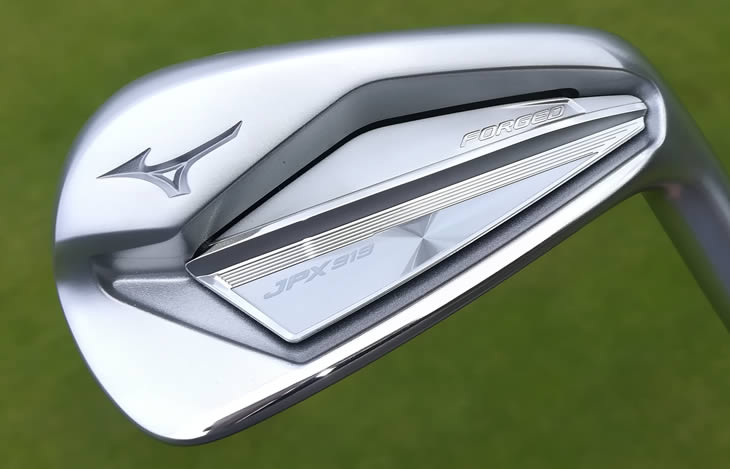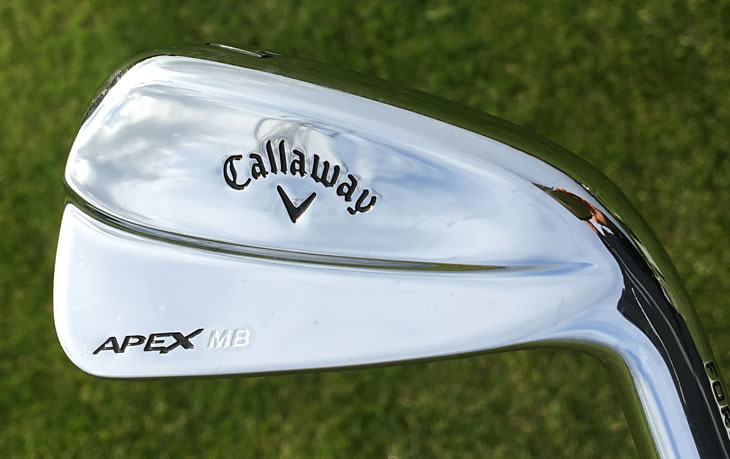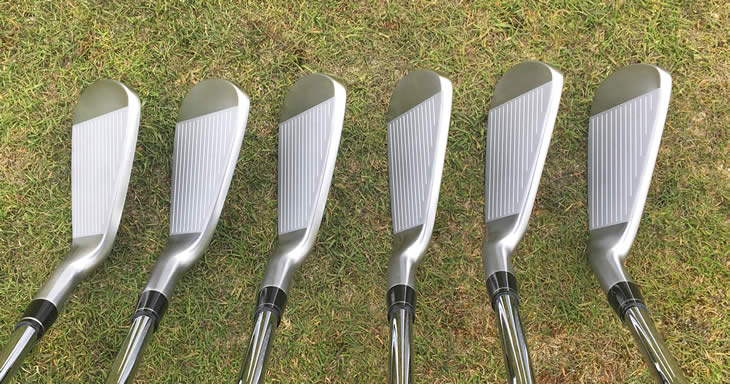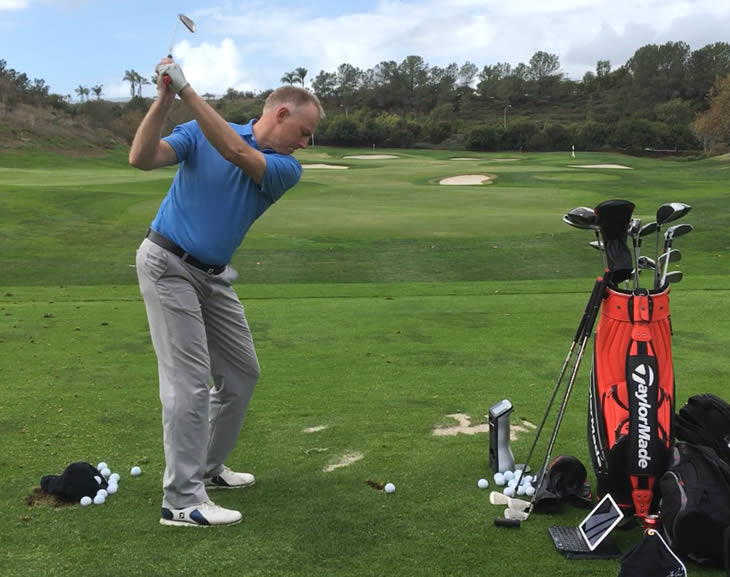Irons make up the vast majority of the clubs in our bags, so finding the right set for you can make a considerable improvement to your game. There are many types of irons with different specifications, so this page will help you to the perfect set of irons.
Types of Irons For Golf
Forged Irons
Forging a club is very similar to what the village blacksmith used to do. The metal is sunk into a rough shape, then hammered into the desired shape. The manufacturer then has a raw forged iron, which is a close approximation of the final club head. The carbon steel clubhead is then finished by milling, grinding and polishing.

The end result is a solid looking, one-piece iron that has a reduced sweet spot. Typically, forged irons are aimed towards good players who place a higher importance on the feel of the club and the ability to shape shots and control trajectory.
Cast Irons
The alternative to forged irons is the cast iron. This type of iron involves pouring the liquid metal into a mould, which allows manufacturers to make more complex head designs. For that reason, cast irons are more suited to irons that are multi-material, perimeter weighted and intricate. The casting process is easier and cheaper than forged irons, which is the reason for the lower price tag.
Designs of Irons
Blade Irons

Blade irons are designed for the game’s better players and feature a thin face, a thin top line and a compact hitting area. Blades generally distribute weight evenly throughout the entire head, producing a small "sweet spot" in the centre of the head.
Because more weight is placed behind the sweet spot it offers more feel and ability to shape a shot than a cavity back, hence why blade irons are sometimes referred to as muscle backs.
Cavity Back Irons

A cavity back iron is a club that positions a recess or cavity in the back of the head, concentrating more weight on the perimeter. By adding more weight to the edges of the clubhead, manufacturers are able to increase the Moment of Inertia (MOI) or forgiveness of the club. Typically a larger clubhead will be paired with a thin clubface, which means off-centre shots fly longer and straighter than an off-centre shot with a blade iron.
This increased forgiveness reduces feel and means that the cavity back iron is more suited to mid to high handicap golfer who benefit from the larger sweet spot.
Sets Of Irons
Irons are usually sold in sets of up to 9 irons. Within each set the irons are numbered to correspond to the loft of the club. The long irons in a set are usually numbers 2, 3 and 4, although these days it is rare to see a 2 or even a 3 iron.
Mid-irons are numbers 5, 6 and 7 and short irons are numbers 8, 9 and wedges such as a Pitching Wedge (PW), Gap or Attack wedge (GW or AW) and a Sand Wedge (SW)
Hybrid Sets Of Irons

Aimed towards players who struggle to hit longer irons, the hybrid iron set progresses from cavity back short irons, through hollow back or reduced cavity mid irons to part-iron/part-wood hybrid clubs.
The benefits of this type of set are clear. The cavity back short irons offer maximum forgiveness and control for shorter shots into greens. Following that, the hollow back mid irons move the weight (and therefore centre of gravity) of the club head lower and further back on the club to produce easily-hit high mid iron shots.
Lastly, the long irons combine fairway wood distance with the control and accuracy of a long iron. For a high-handicap or older player, this set could provide the perfect mix to help your iron-play.
Shafts
Steel Shafts
The most commonly chosen shaft for irons is steel. Steel is stronger and heavier than graphite, meaning it produces less flex and is more consistent and accurate. The carbon steel or stainless steel used in shafts is thick and offers consistent torque and flexibility, allowing you to have the same flex and stiffness in your 4 iron as you have in your 9 iron. The reduced price and highly durable nature of the metal make it a popular choice for all golfers.
Graphite Shafts
Not as common as steel in the iron market, graphite can still be a great advantage because it is lightweight and flexible. This enables you to increase swing speed and perhaps unlock more distance in your game.
The drawback of graphite is the feel from the shaft. A stiff graphite shaft will not feel like a stiff steel shaft and may mean the feel is not consistent through a graphite-shafted set of irons. Another drawback is price, as the process of making graphite shafts is more expensive than steel. However, if you are an older, junior or lady golfer who perhaps prefers a light feeling club, then the extra money you spend may benefit your game.
Multi-Material Shafts
A less common method of shaft construction is the multi-material shaft. This type of shaft combines both steel and graphite in one shaft. It tends to be made up mainly of steel, with a graphite tip. The steel section of the shaft offers a solid shaft that allows players to control the ball flight more. The graphite tip lets the club have a limited amount of 'extra speed into the ball that can help produce more distance. The graphite tip also helps filter out any unwanted vibrations at contact to optimize the feel of each shot.
For more information on shafts, go to the Golf Shafts Buying Guide
How Many Clubs Do I Buy?
This may seem a fairly elementary question but actually there are many options when it comes to deciding exactly which individual clubs you buy.
The most common set of irons is from a 4 iron to pitching wedge (PW). Many better players may choose to buy 3 to 9 iron and leave room to add specialist wedges. A weaker player or older player may decide to choose 5 iron to SW leaving room for fairway woods and utility clubs in their bag in place of the longer irons, whilst using more forgiving wedges provided within the set.

A key influence in choosing the make-up of your set is distance gapping. This means paying attention to the distance you typically hit each club in your bag, and specifically the gaps between them. If you have any noticeable gaps, it may be worth adjusting your set configuration.
Try Before You Buy!
One of the great benefits of buying clubs today, is the option to try clubs and visit demo days. We could not recommend this highly enough. Just finding the right clubs for you is fine, but unless you actually use them and see how they hit then you may never be sure you are getting the perfect set.
Custom Fitting
Custom fitting is a service offered by all the major manufacturers. The ability to adapt the specifications of irons to match your size and swing is a very useful method of buying clubs. The average set is designed for a player who is around 180 cm (5 foot 10 inches) tall. If you are not this height it is likely that you would benefit from custom fitting.
Fitting involves customising the length of shaft and lie as the taller you are the longer shaft you will require and you may perhaps need a more upright lie. The shaft stiffness can also be adjusted to suit your swing speed so that the club does not arrive too open or shut at impact. Even the head design can be custom fitted to your swing and desired shots.

Custom fitting will take approximately 30 to 60 minutes at your local pro shop or golf shop. Some manufacturers also have fully equipped fitting centres with all the latest technology to fit you like a Tour Pro.
It can cost you a little more than buying a standard set of clubs, however many manufacturers will do this for free if you end up buying a set with them. Ultimately any small cost will probably save you money in the long run, as you will have a set perfectly fitted for you.
Demo Days
Demo days where manufacturers offer all golfers the chance to try out all their latest equipment and get advice on specifications and any other questions you might have. Some demo days even have custom fitting trucks with computer analysis equipment to analyse you swing and build you a club to order there and then.